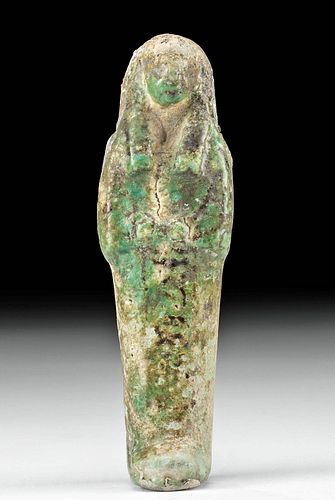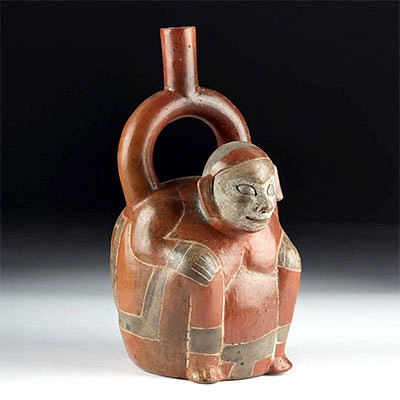Egyptian Faience Ushabti w/ Blue Green Glaze
Lot 7
About Seller
Artemis Fine Arts
686 S Taylor Ave, Ste 106
Louisville, CO 80027
United States
Selling antiquities, ancient and ethnographic art online since 1993, Artemis Gallery specializes in Classical Antiquities (Egyptian, Greek, Roman, Near Eastern), Asian, Pre-Columbian, African / Tribal / Oceanographic art. Our extensive inventory includes pottery, stone, metal, wood, glass and textil...Read more
Estimate:
$500 - $750
Absentee vs Live bid
Two ways to bid:
- Leave a max absentee bid and the platform will bid on your behalf up to your maximum bid during the live auction.
- Bid live during the auction and your bids will be submitted real-time to the auctioneer.
Bid Increments
| Price | Bid Increment |
|---|---|
| $0 | $25 |
| $300 | $50 |
| $1,000 | $100 |
| $2,000 | $250 |
| $5,000 | $500 |
| $10,000 | $1,000 |
| $20,000 | $2,500 |
| $50,000 | $5,000 |
| $100,000 | $10,000 |
| $200,000 | $20,000 |
About Auction
By Artemis Fine Arts
Jul 8, 2021
Set Reminder
2021-07-08 10:00:00
2021-07-08 10:00:00
America/New_York
Bidsquare
Bidsquare : CLEARANCE | Ancient & Ethnographic Art
https://www.bidsquare.com/auctions/artemis-gallery/clearance-ancient-ethnographic-art-7173
Kick off summer with our clearance sale featuring discounted pricing and many new items at superb prices! Asian art, Classical antiquities from Egypt, Greece, Italy, and the Near East...plus Pre-Columbian, Tribal, Russian Icons & Enamelware, Spanish Colonial, Fine Art, Fossils, more! Artemis Fine Arts info@artemisgallery.com
Kick off summer with our clearance sale featuring discounted pricing and many new items at superb prices! Asian art, Classical antiquities from Egypt, Greece, Italy, and the Near East...plus Pre-Columbian, Tribal, Russian Icons & Enamelware, Spanish Colonial, Fine Art, Fossils, more! Artemis Fine Arts info@artemisgallery.com
- Lot Description
**First Time At Auction**
Ancient Egypt, New Kingdom to Third Intermediate Period, 20th to 21st Dynasty, ca. 1189 to 943 BCE. A wonderful ushabti built by hand from white faience and covered in layers of lustrous blue-green glaze. The mummiform figure stands upon fused legs and holds a pick and hoe in arms crossed atop the broad chest. The protruding face presents with black-painted features, framed by lengthy black wig lappets. Indecipherable remains of hieroglyphs are inscribed vertically along the body of the ancient figure. Size: 1.2" W x 4" H (3 cm x 10.2 cm)
Shabti (or ushabti) dolls are figures shaped like adult male or female mummies wearing traditional ancient Egyptian headdresses. The ancient Egyptians believed that after they died, their spirits would have to work in the "Field of Reeds" owned by the god of the underworld, Osiris. This meant doing agricultural labor was required by all members of society, from workers to pharaohs. By the Third Intermediate period, this practice had become so necessary and elaborate that some tombs contained one worker for every day of the year and thirty-six overseers, each responsible for ten laborers. The wealthier nobility in Egyptian society were able to have shabtis made of coveted faience, and blue faience was meant to reflect the color of the river Nile both on earth and in the afterlife.
Provenance: private Corpus Christi, Texas, USA estate collection, acquired 1960s to 1970s
All items legal to buy/sell under U.S. Statute covering cultural patrimony Code 2600, CHAPTER 14, and are guaranteed to be as described or your money back.
A Certificate of Authenticity will accompany all winning bids.
PLEASE NOTE: Due to recent increases of shipments being seized by Australian customs (even for items with pre-UNESCO provenance), we will no longer ship most Antiquities and ancient Chinese art to Australia. For categories of items that are acceptable to ship to Australia, please contact us directly or work with your local customs brokerage firm.
#165232Collection label on verso. Repair and restoration to base. Expected abrasions and pitting, commensurate with age. Otherwise, excellent with nice remaining pigments.Condition
- Shipping Info
-
All shipping is handled in-house for your convenience. Your invoice from Artemis Gallery will include shipping calculation instructions. If in doubt, please inquire BEFORE bidding for estimated shipping costs for individual items.
-
- Buyer's Premium



 EUR
EUR CAD
CAD AUD
AUD GBP
GBP MXN
MXN HKD
HKD CNY
CNY MYR
MYR SEK
SEK SGD
SGD CHF
CHF THB
THB














